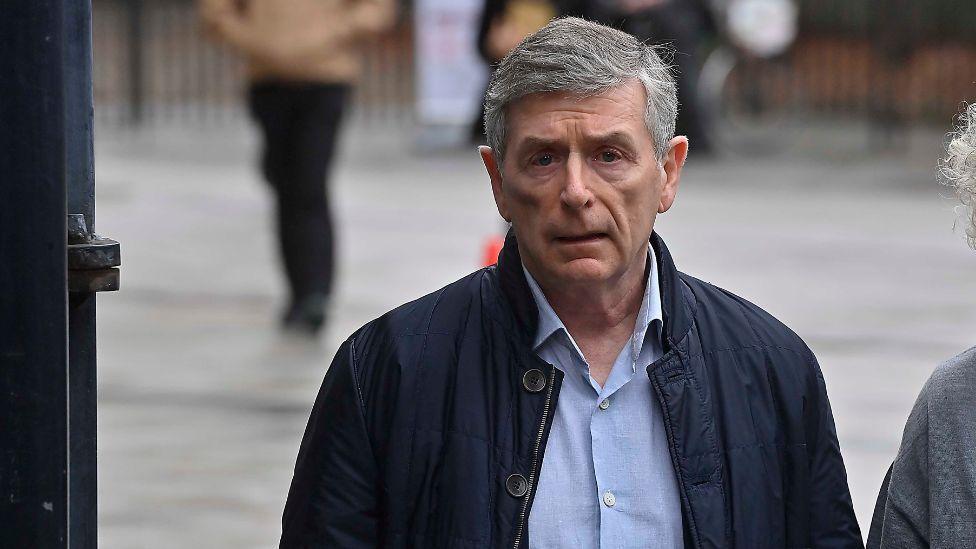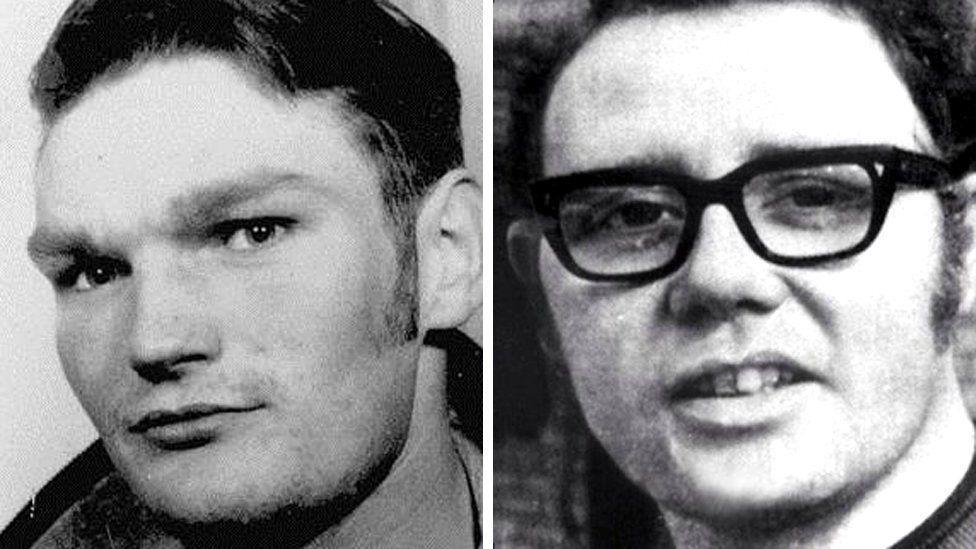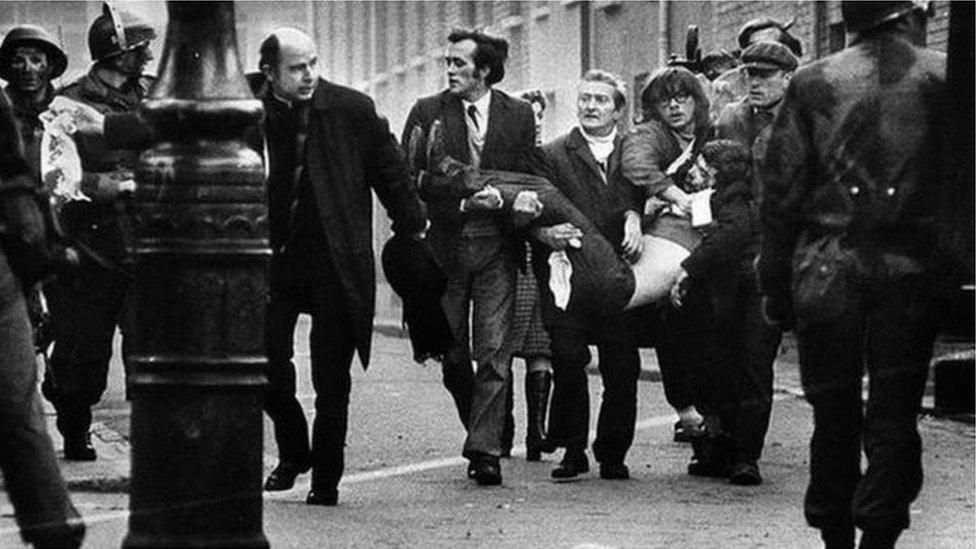Bloody Sunday trial hears of moment teenager was shot in face

Michael Quinn, who was a 17-year-old schoolboy in 1972, testified at Belfast Crown Court on Thursday
- Published
A man injured on Bloody Sunday in Londonderry has described the moment a shot struck his face as he tried to run to safety.
Michael Quinn, who was a 17-year-old schoolboy in 1972, was testifying at the trial of Soldier F, who denies two charges of murder and five charges of attempted murder.
Mr Quinn told Belfast Crown Court he was trying to escape from Glenfada Park when he was hit.
He said the bullet grazed his shoulder, struck his face "and exited through my nose".
Soldier F, who cannot be named for legal reasons, is accused of the murders of James Wray, 22, and William McKinney, 26.
They were among 13 people who were shot dead by the Parachute Regiment at a civil rights demonstration in the Bogside area of Derry on 30 January, 1972.
He is further accused of attempting to murder Mr Quinn, Patrick O'Donnell, Joseph Friel, Joe Mahon, and an unknown person.
Soldier F's non-jury trial began in Belfast last month.
'Apprehensive'

Soldier F is accused of murdering James Wray (left) and William McKinney
Mr Quinn recounted attending the civil rights' march, he said he was a bit "apprehensive" because paratroopers were on the streets.
He told the court that James Wray had asked him to help carry a banner on the march and he had done so.
Mr Quinn described trouble breaking out and hearing army gunfire.
At this time, he said, he was at a rubble barricade in the William Street area where he saw soldiers jumping from two army Saracens.
One of the soldiers, he told the court, was swinging the butt of a rifle "like a club".
"I hadn't seen that before, it was quite shocking," he said.
'Flesh and blood breaking away'
Mr Quinn told the court he went into Glenfada Park to seek cover between the courtyard's maisonettes and remembered someone telling a youth to "put away" a nail bomb as "you'll only get people killed".
Mr Quinn told the court he then saw a man being shot.
"I could see he was shot… I heard him call out, scream. I looked at him and saw a ring of blood emerging on his leg and he was collapsing to the ground."
Moments later, Mr Quinn said he heard a shout of "they're coming in", a reference to soldiers.
He then tried to leave, the court was told, and was shot as he moved in a crouching position across the courtyard.
"As I was approaching the exit, I felt myself being struck by the bullet…I could see the flesh and blood breaking away from my face."
Mr Quinn stumbled to a nearby street where he received help before being taken to hospital.
'There's the Army coming'
The trial also heard evidence from eyewitnesses, including Derek McFeely.
He told told the court he was 17 at the time and had gone on the march with a friend.
When it stopped at William Street, he said, people were wondering what was going on.
He told the court he remembered soldiers being in a nearby tall derelict building and that "all of a sudden a shot rang out".
Mr McFeely told the court a young man standing beside him had been shot.
Along with three other men, Mr McFeely said, he carried him to a house before making his way to Glenfada Park, thinking it would be safer.
"When we entered the courtyard... it is my recollection there were two bodies lying on the ground, " he told the court.
Mr McFeely said he went over to one of the bodies, and "my intention was to turn him over and then there was a call 'there's the Army coming'.''
He said he saw a group of "four or five soldiers" enter Glenfada Park and running with rifles across their chest.
Mr McFeely told the court he "heard three or four shots" as he was "making a fast exit" from Glenfada Park.
'He fell and didn't move'
A third witness John Shiels also gave evidence on Thursday.
He attended the civil rights march and ended up in the bedroom of a flat in Glenfada Park, after the initial trouble broke out.
Mr Shiels told Judge Patrick Lynch he was looking out the window as a soldier arrived into the courtyard.
"He shouldered his rifle, fired it, and shot a fella running.
"He had nothing in his hands. He was just running," Mr Shiels said.
"He fell and didn't move."
Minutes later, Mr Shiels went out into the courtyard and saw a group of people surrounding a body.
He told the court one of the group said to him: "There's bodies everywhere."
The trial continues.
Who is Soldier F?
Soldier F is a former British soldier who served with the Army's Parachute Regiment in Northern Ireland during the Troubles.
He cannot be named due to an interim court order granting his anonymity.
The decision to charge Soldier F was taken by the Public Prosecution Service (PPS) in 2019.
He was one of 18 former soldiers reported to the PPS as a result of a police investigation, which followed the public inquiry into Bloody Sunday conducted by Lord Saville.
But he was the only one charged.
Two years later, the PPS dropped the case after the collapse of the trial of two other veterans who had been accused of a 1972 murder in Belfast.
But the prosecution resumed in 2022 after a legal challenge.
